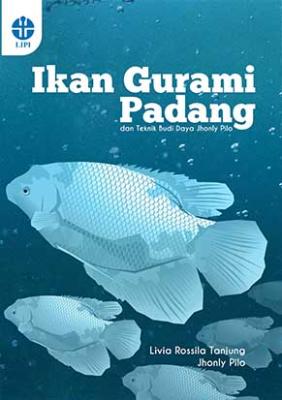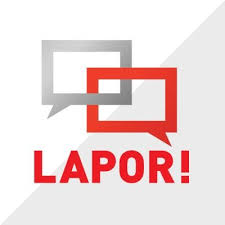Ikan Gurami Padang dan Teknik Budidaya Jhonly Pilo
Keywords:
Ikan Gurami, BudidaySynopsis
Ikan Gurami merupakan salah satu komoditas utama perikanan air tawar. Selain permintaan domestik yang tinggi, peluang ekspor ikan Gurami juga sangat menjanjikan karena minat pasar internasional yang sangat besar. Biasa disajikan pada acara-acara khusus di sebagian masyarakat Indonesia, ikan ini memiliki harga jual yang lebih tinggi dibanding dengan produk ikan air tawar sejenis. Meskipun demikian, jumlah petani dan produksi ikan Gurami masih sangat kecil. Jhonly Pilo adalah seorang pembudidaya ikan Gurami yang telah lama berkecimpung di sektor perikanan air tawar. Ia berhasil menemukan dan mengembangkan teknik-teknik budi daya ikan Gurami yang inovatif dan ekonomis. Buku Ikan Gurami Padang dan Teknik Budi Daya Jhonly Pilo akan membagikan kepada pembaca kiat-kiat dan berbagai inovasi yang dikembangkan Jhonly Pilo dalam pembudidayaan ikan Gurami. Buku ini diharapkan akan mampu membangkitkan minat usaha masyarakat di bidang perikanan air tawar, khususnya pembudidayaan ikan Gurami. Para peneliti juga dapat menggunakan buku ini sebagai referensi utama dalam berbagai penelitian terkait.
Downloads
References
Andersen N. M. & Weir, T.A. (2004). Australian water bugs. eir biology and identification (Hemiptera-Heteroptera, Gerromorpha & Nepomorpha). CSIRO Publishing. 344 p.
Azad I. S., Rajendran, K.V, Rajan, J.J.S, Vijayan, K.K., & Santiago, T.C. (2001). Virulence and histopathology of Aeromonas hydrophila (Sah 93) in experimentally infected Tilapia, Oreochromis mossambicus (L.). Journal of Aquaculture in Tropics, 16, 265–275.
Bick, G. H. (1951). Notes on Oklahoma dragon ies. Journal of the Tennessee Academy of Science, 26, 178–180.
Bottarelli, E., & Ossiprandi, M.C. (1999). Aeromonas infection: An update. A paper presented at the Course La nuova cultura delle produzioni animali nel contesto del l'Unione Europea, University of Parma, Faculty of Veterinary Medicine, Parma.
Burr S. E., Pugovkin, D., Wahli, T., Segner, H., & Frey, J. (2005). Attenuated virulence of an Aeromonas salmonicida subsp. salmonicida type III secretion mutant in a Rainbow Trout model. Microbiology, 151, 2111–2118.
Chippindale, A. M. (2008). Zeolites really rock! DeLisleology. 5 pp.
Cipriano, R. C. (2001). Aeromonas hydrophila and Motile Aeromonad Septicemias of sh. Fish Disease Lea et 68. United States Department of the Interior. Fish and Wildlife Service Division of Fishery Research Washington, D. C. 20240.
Delbare, D., & Dhert, P. (1996). Cladocerans, Nematodes and Trochophora larvae in manual on the production and use of live food for aquaculture. In Lavens and Sorgeloos (eds.), FAO Fisheries Technical Paper, p. 283–295.
Dixon, B. A., & Issvoran, G.S. (1992). e activity of ce iofur sodium for Aeromonas spp. isolated from ornamental sh. Journal of Wildlife Disease, 28(3), 453–456.
Drees, B.M., & Jackman, J.A. (1998). A eld guide to common Texas insects. Gulf Publishing Company. p. 46
Francis-Floyd, R. (2002). Aeromonas infections. FA14 Document, IFAS Extension, University of Florida.
Garrison, R. W. (1997). Nomina insecta nearctica: A check list of the insects of North America. Vol. 4: Non-holometabolous orders. Rockville: Entomological Information Services. p. 551–580.
Hariana, A. (2006). Tumbuhan obat dan khasiatnya seri 3. Penebar Swadaya Horne, A. J. & Goldman, C. R. (1994). Lake ecology overview (Chapter 1).
Limnology. 2nd edition. New York: McGraw-Hill Co.
Hossain, M. J., Sun, D., McGarey, D.J., Wrenn, S., Alexander, L.M., Martino, M.E., Xing, Y., Terhune, J.S., & Liles, M.R. (2014). An Asian origin of virulent Aeromonas hydrophila responsible for disease epidemics in United States-farmed cat sh. mBio, 5(3), e00848-14. doi:10.1128/ mBio.00848-14.
Humason, G. L. (1962). Animal tissue techniques. Los Alamos Scienti c Laboratories. W. H. Freeman and Company. United States of America. 492 pp.
Inoda, T. (2012). Predaceous diving beetle, Dytiscus sharpi sharpi (Coleoptera: Dytiscidae) larvae avoid cannibalism by recognizing prey. Zoological Science, 29(9), 547–552.
janda, J. M. (1991). Recent advances in the study of the taxonomy, pathogenicity, and infectious syndrome associated with the genus Aeromonas. Clinical Microbiology Reviews, (4), 397.
Janda, J. M. (2001). Aeromonas and Plesiomonas. In Sussman, M. (ed), Molecular Medical Microbiology, p. 1237–1270. New York: Academic Press.
Kementerian Kelautan dan Perikanan. (2010). Statistik kelautan dan perikanan 2010. p.107 & 122.
Kementerian Kelautan dan Perikanan. (2011). Statistik kelautan dan perikanan 2010. p.104 & 119.
Kementerian Kelautan dan Perikanan. (2012). Statistik kelautan dan perikanan 2011. p.139 & 154.
Lamb, L. (1925). A tabular account of the di erences between the earlier instars of Pantala avescens (Odonata: Libellulidae). Transactions of the American Entomological Society, 50, 289–312.
Larson, D. J., Alarie, Y., & Roughley, R.E. (2007). Predaceous diving beetles (Coleoptera: Dytiscidae) of the Nearctic Region, with emphasis on the fauna of Canada and Alaska. p. 24–70.
Le?ger, P., Bengtson, D.A., Sorgeloos, P., Simpson, K.L., & Beck, A.D. (1987). e nutritional value of Artemia: A review. In Sorgeloos, P., Bengston D.A, Decleir, W., & Jaspers, E. (eds.), Artemia Research and its Applications. Vol. 3. Ecology, culturing, use in aquaculture. Wetteren: Universa Press. 556 p.
Markle, S. (2008). Diving beetles: Underwater insect predators. Minneapolis: Lerner Publications Company. Lerner Publishing Group, Inc. p. 5–113.
Matthews, P. G. & Seymour, R.S. (2011). Oxygen binding properties of Backswimmer (Notonectidae, Anisops) haemoglobin, determined in vivo. J. Insect Physiol., 57(12), 1698–706.
McCa erty, W. P. (1981). Aquatic entomology. Boston: Science Books Intl. 448 p
Meryam, M. M., Diah, K., & Adi, P. (2005). Molecular marker development of Gouramy sh (Osphronemus gouramy) which is resistant to Aeromo- nas hydrophila using random Ampli ed Polymorphic DNA (RAPD) method: I. obtaining resistant gouramy sh and optimizing PCR
reaction. Asahigarasu Zaidan Jyosei Kenkyu Seika Hokoku (Web), U0002A, WEB ONLY 05F-2-6(2005).
Murray, P.R., Pfaller, M.A., & Rosenthal, K.S. (2005). Vibrio and Aeromonas. In Medical Microbiology, Chapter 32: 339–346. 5th Edition. Elsevier.
Paulson, D. R., & Dunkle, S.W. (2002). A checklist of North American Odonata including english name, etymology, type locality, and distribution. Slater Museum of Natural History, University of Puget Sound. Occasional Paper no. 56. e University of Puget Sound. Tacoma, Washington, USA. 88 pp.
Steinmann, H. (1997). World catalogue of Odonata II. Volume II Anisoptera. Berlin: Walter de Gruyter. p. 542.
Takashima, F & Hibiya, T. (eds). (1995). An atlas of sh histology: Normal and pathological features. Second Edition. Tokyo: Kodansha, Stuttgart, New York. 195 p.
eischinger, G., & Hawking, J. (2006). e complete eld guide to Dragon ies of Australia. CSIRO Publishing. p. 346–353.
Trust, T. J., Bull, L.M., Currie, B.R., & Buckley, J.T. (1974). Obligate anaerobic bacteria in the gastrointestinal microflora of the Grass Carp (Ctenopharyngodon idella), Gold sh (Carassius auratus), and Rainbow Trout (Salmo gairdneri)”. Journal of the Fisheries Research Board of Canada, 36, 1174–1179.
Varnam, A.H., & Evans, M.G. (1991). Food pathogens: An illustrated text. Wolfe Publ. Ltd, p. 185.
Warren, A. (1915). A study of the food habits of the Hawaiian dragon ies or Pinau with reference to their economic relation to other insects. College of Hawaii Publications. Bulletin 3. 45 pp.
West, J. 2006. Dragon ies and Damsel ies. In Water for a Healthy Country. National Research Flagships. 9 pp. CSIRO Publishing.
White, M.R., and Swann, L. (1991). Diagnosis and treatment of Aeromonas hydrophila infection of sh. Aquaculture extension. Purdue University Fact Sheet AS-461, 1–2.
Yadav, M. (2003). Biology of insects. Discovery Publishing House. p. 36. Yee, D. A. (2014). An introduction to the Dytiscidae: eir diversity, historical
importance, cultural signi cance and other musings. In Ecology,
Systematics, and the Natural History of Predaceous Diving Beetles (Coleoptera: Dytiscidae). XVIII, 468 p.
INTERNET
Anonim. (2004). Family Dytiscidae. In Water for A Healthy Country. CSIRO. Updated 2 July 2004. www.cpbr.gov.au/cpbr/WfHC/Dytiscidae/index. html. Diakses tanggal 25 Sep 2014.
Bright, E. (2006). Aquatic insects of Michigan. Museum of Zoology, Insect Division and School of Natural Resources and Environment. University of Michigan. insects.ummz.lsa.umich.edu/~ethanbr/aim/keys/odonata/ keys_ oom_libellulidae_pantala.htm. Diakses tanggal 25 Sep 2014.
Bryant, P. J., & Jacob-Schram, B. (2014). Backswimmer Notonecta unifasciata. http://nathistoc.bio.uci.edu/hemipt/Notonectid.htm Diakses tanggal 25 Sep 2014.
China.cn. (tt). 4A Zeolite powder (Gambar). http://htchemical.en.china.cn/ selling-leads/img_1112976137_1.html. Diakses tanggal 15 Okt 2014.
Creationwiki. (2013). Backswimmer. http://creationwiki.org/Backswimmer. Diakses tanggal 25 Sep 2014.
Delgado, G. (2010). Microorganism of the Month: Aeromonas species. https:// www.emlab.com/s/sampling/env-report-06-2007.html. Diakses tanggal 27 Juni 2013.
Dragon ies and damsel ies (Order: Odonata). (n.d). Amateur Entomologists' Society. Diakses dari http://www.amentsoc.org/insects/fact- les/orders/ odonata.html
El Gamal, A. (2012). Daphnia (characteristics, feeding, reproduction, reactions to environmental stress). Fish Consulting Group. http:// shconsult.org/?p=10710. Diakses tanggal 29 Jan 2014.
Endragana Putra, CV. (tt). Dolomit (Gambar). http://endraganaputra. indonetwork.co.id/2959178/dolomit.htm. Diakses tanggal 15 Okt 2014.
Estiara, D. (2013). Klasi kasi ilmiah capung dan capung jarum (Odonata). http://insectiara.blogspot.com/2013/01/klasi kasi-ilmiah-capung-dan- capung.html. Diakses tanggal 1 Jul 2013.
Firman Ashari, R. (2012). Fakta tentang Capung. http://rizal rmanashari. blogspot.com/2012/01/fakta-tentang-capung.html. Diakses tanggal 17 Okt 2013.
Friedman, H. (2014). e mineral dolomite. http://www.minerals.net/mineral/ dolomite.aspx. Diakses tanggal 15 Okt 2014.
Harjono, I. (2004). Zeolit, Bahan Pembenah Tanah. http://www.suaramerdeka. com/harian/0402/23/ragam3.htm. Diakses tanggal 15 Okt 2014.
Jasmigration. (2008). Migrant of the day Onathumbikal. https://jasmigration. les.wordpress.com/2008/04/pantala_ avescens_006_std.jpg http:// pinkyrexa. les.wordpress.com/2013/03/water- ea.jpg. Diakses tanggal 17 Okt 2013.
Myers P., Espinosa R., Parr C.S., Jones, T, Hammond, G.S., & Dewey, T.A. (2014). e animal diversity. http://animaldiversity.org. Diakses tanggal 25 Sep 2014.
Nadjib, M. (2013, Februari 11). Situasi Artemia [Komentar dalam forum online]. Diakses pada 13 Oktober 2014 dari http://forum.aquaculture- mai.org/index.php?topic=131.msg354#msg354
Nasa, D. S. (2012). Fungsi kapur dolomit dan kapur zeolit. www.viternaplus. com/ 2012/10/fungsi-kapur-dolomit-kapur-zeolit.html. Diakses tanggal 15 Okt 2014.
Rowley, P. (2014). Backswimmers. www. ycra angling.com/index.asp?p=118. Diakses tanggal 25 Sep 2014.
Sea surface salinity: De nition and units. (n.d). Diakses dari http://www. salinityremotesensing.ifremer.fr/sea-surface-salinity/de nition-and- units
Strohmeyer, C. (2013). Treatment, identi cation of Aeromonas, Furunculosis and Vibrio in akuariums and ponds. http://www. americanakuariumproducts. com/vibrio_aeromonas.html. Updated 6/26/13. Diakses tanggal 22 Nov 2014.
Visser, G. H. (2010). Corixa, way of life. http://www.microcosmos.nl /bugs2/ lbleven.htm. Diakses tanggal 29 Jan 2014.
Waterwereld. (2002). Backswimmer. http://www.waterwereld.nu/ ruggezwemme reng.php. Diakses tanggal 29 Jan 2014.
Watson, B. (2011). Backswimmer. http://agrilife.org/4-hentomology/species/ backswimmer/. Diakses tanggal 29 Jan 2014.
Water Backswimmer "Notonectids" (True Bug). (n.d). Diakses dari http:// www.bugfacts.net/water-backswimmer.php
Water Boatmen, Backswimmers (Family Corixidae, Notonectidae). (n.d). Diakses dari https://www4.uwm.edu/fieldstation/naturalhistory/ bugo heweek/water-boatmen-and-backswimmers.cfm
Zonaikan. (2012). Kutu air Daphnia. http://zonaikan.files.wordpress. com/2012/05/kutu-air-daphnia.jpg. Diakses tanggal 29 Jan 2014.

Downloads
Published
Series
Categories
License

This work is licensed under a Creative Commons Attribution-NonCommercial-ShareAlike 4.0 International License.






























